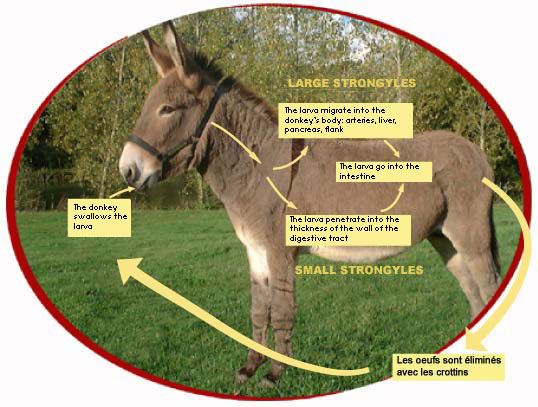|
The strongyles are parasites often found in the
horse and the donkey of all ages. There are many species, their
are some which can be dangerous for the donkey.
Small strongyles (or Cyathostomes):
They measure 5 to 10mm in length, they are in more than 80%
of equids and they are the parasite more frequentlt found.
Large strongyles (or Strongylus):
They measure 2 to 5cm in length. They are frequently in the large
intestine and the larvae can often be the cause of severe various
disorders. Among the three principal species (Stronglylus vulgaris,
Strongylus edentatus, Strongylus equinus), the first is called
"the horses killer" it is the most dangerous because its
larva is responsible for the "verminous arteritis".
| Contamination and cycle of
life |
 |
When the climate is mild and wet, the strongyles' eggs which are
in the meadows, develop into larvae and the donkey can then swallow
them.
Small strongyles:
The larvae penetrate in through the wall of the digestive tract.
They can continue their growth to become adults, or to encyst during
a few weeks or month's while waiting for better conditions. Once
adult, the strongyles return to the intestine.
Large strongyles:
When they arrive in the small intestine, these larvae cross through
the intestinal wall, then will go slowly into the small arteries
of the intestine, then into the large arterials trunks which irrigate
the digestive tract. That can involve the formation of clots, then
aneurisms. Larvae go through the blood way to go into the intestinal
wall.

Cycles of the strongyles
When they return into the intestine, larvae are transformed into
adults, and then lay thousands of eggs which will be eliminated
in the faeces.
| Symptoms |
 |
When they are in the intestine, the clinical signs gradually appear
with softened and malodorous faeces, diarrhoea, loss of appetite
and fatigability.
Small strongyles:
These strongyles parasites are found in all equids, but are especially
dangerous for the young animals. They can cause in the winter and
spring, various digestive disorders and constitute a factor which
supporting the appearance colics.
Large strongyles:
On top of the digestive symptom, the disorder occasioned by the
strongyles' larva can be very variable: obstruction of the arteries,
aneurisms, the effects touch the liver and pancreas, peritonitis,
fever... In the most serious cases, we can see a brutal rupture
of aneurisms and then death occurs by internal bleeding.
| Prevention - Treatment |
 |
Small strongyles:
Use active worming against the larval stage. It is advised to worm
at the end of autumn (period of encystations) and at the beginning
of spring when the cysts are transformed again into larva.
To reduce the level of infestation of the pastures, we will use
active worming against the adults in June and September. In total
four annual wormings.
Large strongyles:
It is advised to worm in the middle of spring or beginning of autumn
when the climatic conditions are favourable for the strongyles growth.
We will choose active products against the adults and especially
for the larva which migrate.
|










